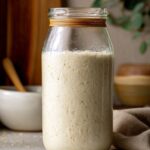Description
This Sourdough Starter Recipe guides you through the simple, natural process of cultivating a live sourdough starter using whole grain rye or wheat flour and all-purpose flour. Perfect for baking artisanal sourdough bread at home, this starter develops rich natural yeast and bacteria over 7 days, ensuring a robust and tangy flavor in your bread. The recipe emphasizes organic ingredients and filtered water to promote a healthy fermentation process.
Ingredients
Scale
Initial Starter
- 100 g Whole Grain Rye Flour or Whole Wheat Flour (preferably organic; about 3/4 cup)
- 100 g Filtered or Spring Water (room temperature)
Feeding Ingredients
- 500 g All-purpose Flour (preferably organic, unbleached)
- 500 g Filtered or Spring Water (room temperature)
Instructions
- Mixing the Starter: In a clean container, combine 100 g of whole grain rye or wheat flour with 100 g of filtered water at room temperature. Stir well until there are no dry patches, and a thick, porridge-like consistency forms. Cover loosely and leave at room temperature (around 70-75°F) to allow natural fermentation to begin.
- Daily Feeding: For the next 7 days, discard half of the starter mixture. Feed the remaining starter with 250 g of all-purpose flour and 250 g of filtered water (both at room temperature). Stir thoroughly, cover loosely, and let sit at room temperature.
- Observation and Maintenance: Each day, observe the starter’s activity. It should begin to bubble and rise, signaling active fermentation. The starter will develop a pleasantly sour aroma. Continue daily feedings until the starter doubles in size within 6-8 hours of feeding, indicating readiness for baking.
- Storage: Once active, you can keep your starter at room temperature with daily feedings or refrigerate it, feeding once a week. Before baking, bring it to room temperature and feed until bubbly and active.
Notes
- Use filtered or spring water to avoid chlorine, which can inhibit fermentation.
- Organic flours promote healthier fermentation due to natural yeasts and bacteria.
- Keep your starter in a loosely covered container to allow airflow but prevent contamination.
- Starter readiness is indicated by doubling in size and a bubbly texture within hours after feeding.
- If a layer of liquid (hooch) forms on top, stir it back in or pour off – it indicates hunger and needs feeding.

